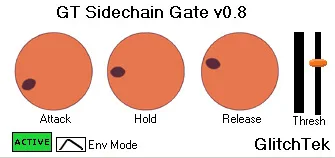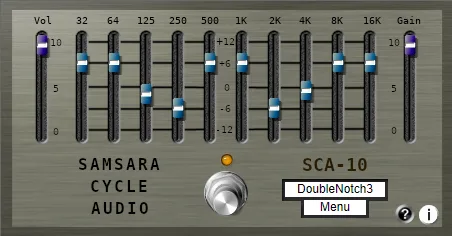GT Sidechain Gate: Your Master of Rhythmic Dynamics from Glitchtek
In the world of modern music production, where groove and dynamics play a key role, the ability to precisely control the level of an audio signal in response to another signal is extremely valuable. This is where GT Sidechain Gate from developer Glitchtek comes in – a compact but powerful VST plugin, created for efficient sidechain gating.
Forget complex settings and confusing interfaces. GT Sidechain Gate offers a simple and intuitive solution for performing one specific, but extremely important task: opening or closing an audio channel based on a signal from another source. This tool is indispensable for creating classic “pumping” effects, forming unique rhythmic patterns, and precisely controlling the dynamics of your tracks.
Whether you’re working on electronic music, hip-hop, or any other genre where rhythm and space matter, GT Sidechain Gate will provide you with the tools you need to bring your creative ideas to life. Its ease of use allows you to quickly integrate it into your workflow, while the sidechain functionality opens the door to a multitude of dynamic and rhythmic possibilities.
What is a Sidechain Gate and why do you need it?
A traditional gate works by closing an audio channel when the signal level falls below a certain threshold and opening it when the level exceeds that threshold. This is useful for suppressing noise or unwanted sounds between useful signals (e.g., the noise of a guitar amplifier between riffs).
Sidechain Gate takes this concept to a new level. Instead of responding to the level of the main signal passing through it, it responds to the level of an external signal – the so-called “sidechain” or “key”. This allows you to use one instrument (e.g., a kick drum) to control the dynamics of another instrument (e.g., a bass or a synth pad).
The main applications of Sidechain Gate include:
- Creating a “pumping” effect, where the level of one instrument rhythmically decreases during the sound of another (classic example: the bass or pad “dips” under the kick drum hits). This adds energy and groove, especially in dance music.
- Rhythmic gating: creating intermittent, “chopped” effects on long sounds (pads, vocals, guitars), using a rhythmic signal (percussion, arpeggiator) as a key.
- Precise noise reduction or gating, where the opening of the gate is synchronized with a useful signal on another track, ensuring maximum clarity.
- Creating complex dynamic interactions between different elements of the mix.
Features of GT Sidechain Gate
The key feature of GT Sidechain Gate is its architecture with two stereo inputs. This is not a standard plugin that is simply placed on a channel and works. It requires a specific routing setup in your Digital Audio Workstation (DAW) to fully utilize the sidechain function.
- Two Stereo Inputs: One input (main) is intended for the audio signal to be processed by the gate. The second input (sidechain or key) receives the signal that will control the gate’s operation.
- Simplicity: According to the developer’s description, the plugin is “simple,” which hints at a concise interface and focus on the main function of sidechain gating.
- Routing Requirements: To use GT Sidechain Gate, your DAW must support flexible routing of VST plugins, allowing you to send a signal from one track (for the sidechain) to the sidechain input of the plugin located on another track (main signal).
How to use GT Sidechain Gate in your project
To start using GT Sidechain Gate, you’ll need to set up routing in your DAW. This usually looks like this:
- Add GT Sidechain Gate to the channel whose audio signal you want to control (e.g., the channel with the bass pad).
- On the channel whose signal you will use as the control (e.g., the channel with the kick drum), create a send to the sidechain input of the GT Sidechain Gate plugin on the channel with the pad.
- Adjust the gate parameters (threshold, attack, decay) in the GT Sidechain Gate plugin, observing how it reacts to the kick drum signal.
The exact steps may vary depending on your DAW, but the general principle is to use the advanced VST routing features that the host supports.
Conclusion
GT Sidechain Gate from Glitchtek is an effective tool for musicians and sound engineers who need a reliable and easy-to-use sidechain gate. Despite its simplicity, it opens up a wide range of possibilities for shaping the dynamics and rhythm of your tracks, from classic pumping to more complex creative effects. If your DAW supports the necessary VST routing, this plugin will be a valuable addition to your dynamic processing arsenal, helping you create a professional, groovy, and clean mix.



